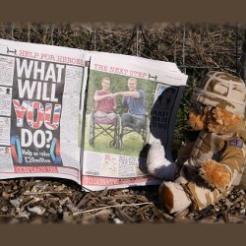After two years of extraordinary growth, Help for Heroes' income has levelled out and expenditure has increased, its latest accounts show.
The four-year-old charity, which supports active military, veterans and their families, saw its income jump by 38 per cent from 2008 to 2009 and by 133 per cent from 2009 to 2010. The latest accounts for 2011, submitted yesterday, show a stabilisation of income with a marginal increase of 2.2 per cent. Its income for 2011 was £46.7m, £1m more than 2010.
Jonathan Ballin, Help for Heroes' chief financial officer, put the change down to a reduction in media interest for the charity: "I think it's a pretty good performance. The charity is still very young and I think we expected at some point that we wouldn't continue to show the incremental increases we've shown in the first three years because the media attention changes and there's lots of other stories.
"In the previous year you've had the royal wedding and the earthquakes in Japan. It goes back to getting a normal share of attention. We got an extraordinary amount of media attention when we first started out, and that's been fantastic."
Gift aid receivable donations decrease
While most areas of the charity's voluntary income increased or remained stable, its gift aid receivable donations plummeted from £2.2m in 2010 to £1.1m in 2011. Ballin advised that this was largely because of a push to ensure that the charity is as compliant with the HMRC rules on gift aid as possible. He says that regulations surrounding the tax relief are still "administratively complicated":
"The government is trying to make it easier but not making huge steps forward. Even for bigger charities like us it's still a relatively complex process to really be compliant in the gift aid process. Big charities have to be absolutely compliant, but it is pretty hard work. It would be nice to see a relaxing of gift aid, without making it a free-for-all."
Trading reduces as costs increase
While its income is levelling Help for Heroes' costs are increasing, with additional requirements for infrastructure and spending on fundraising as the charity gets larger. Employee costs for the charity rose from £616,000 to £1.7m.
Fundraising costs totalled £3.5m in 2011, an increase of £696,000 from 2010. The trustees acknowledged that the increase in costs could be a risk to the charity:
"There is the risk that adverse publicity might lead to a reduction in future donations," they advised in their risk assessment. "The area of particular sensitivity is considered to be the use of funds received, particularly the proportion of voluntary income spent on support costs as opposed to the making of grants."
But the charity advised that this is closely controlled: "To ensure the best possible ratio of voluntary income available for the making of grants, costs are tightly controlled, a number of activities for generating funds are promoted and H4H Trading operates with the aim to make sufficient profits to offset a high proportion of the charity's support costs."
According to the accounts, however, trading income was down in 2011 by 19.4 per cent to £5.2m. Costs of trading increased by 10 per cent to £4.3m. The differences total a 63 per cent reduction in net trading income to £2.6m, leaving £0.9m of costs not covered by its trading income.
Commenting on the difference, Ballin advised that the figures are "distorted" somewhat by the extraordinary trading income the previous year from the Help for Heroes concert, which raised a lot of money.
Legacy and corporate donations spike
The majority of the charity's income remains from voluntary funding, contributing £38.4m to the pot, while activities for generating funds, such as the charity's Sahara Treks and Kilimanjaro climbs, raised £1.6m. The charity's investments earned £1.1m.
Of significance are an increase in legacy donations from £851,000 to £2.1m and a number of key corporate partnerships with organisations such as Vauxhall, the Flight Centre and Premier Foods which have contributed to the voluntary income throughout the year.
Ballin advised that the success of this year's corporate income and legacy donations will inform the charity's strategy going forward: "I think we've learnt that legacies and corporate income are really big opportunities for us. We've got to work very hard to get that now and we're looking at our capability to support both areas."
Grantmaking
This year has seen significant grantmaking from the charity, which expended £28.8m of grants to other relevant programmes and organisations such as Combat Stress, which received £1m, and the Not Forgotten Association, which received £150,000. A further £29.5m was distributed to Help for Heroes' new personal recovery centres, including Tedworth House. The centre opened its doors in July 2011 while the building is currently undertaking a £20m renovation to make it suitable for recovering soldiers' needs, and is expected to be fully operational by September this year.









